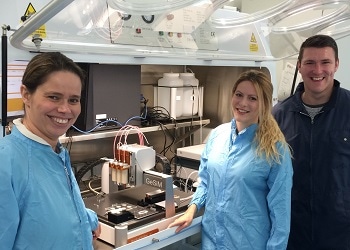Cambridge, UK, 3rd May 2016: Analytik, leading suppliers of innovative analytical instrumentation, report on the research program running at the University of Brighton by the Brighton Centre for Regenerative Medicine where a GeSiM BioScaffolder system is being used to develop bionic histological lattices for a variety of tissues for regenerative medicine applications.
 Professor Mara Cercignani, Miss Ella Hodder and Dr Mark Best of the BCRM group at the University of Brighton with their GeSiM 3D BioScaffolder printer
Professor Mara Cercignani, Miss Ella Hodder and Dr Mark Best of the BCRM group at the University of Brighton with their GeSiM 3D BioScaffolder printer
The interdisciplinary character of the BCRM allows the implementation of a research strategy based on the control of biological processes through the means of advanced, biomimetic and bioresponsive biomaterials suitable for minimally-invasive surgery. The surfaces of medical implants and scaffolds are functionalised with macromolecules, thin films and polymeric coatings capable of controlling cell activity at the interface between the implant and the surrounding biological environment - thus favouring its integration with the host tissue.
As part of this work, the Centre has invested in a novel printing solution – the BioScaffolder 3.1™ from GeSiM. This is being used to develop bionic histological lattices for a variety of tissues for the physiologically-reflective testing of cells and for the clinically-reflective in vitro testing of drugs/ biomaterials/ bioactive compounds. The motivation for this work comes from a need for the assembly of biomimetic micro-environments for both novel in vitro models of cell culture and regenerative medicine applications. Still at the early stages of the project, Professor Matteo Santin, leader of the BCRM, says he has been impressed with the ability of the BioScaffolder system to “plot with cells in a precise and reproducible manner.”
Others in the multidisciplinary team are equally excited by the system. Dr Mark Best is a research fellow at the BCRM. He is part of the team building biological interfaces.
I am excited with the ability to be able to integrate cells into scaffolds. The novelty of it interests me. It is great being at the forefront of such cutting edge technology. I can see a great future in the technique and to producing several publications using it in the field of biomaterials.
Dr Mark Best is a research fellow at the BCRM
Dr Derek Covill is from the Department of Computing, Engineering & Mathematics and is a BCRM member contributing to the activities of the Centre as a 3D printing specialist. Among his interests is the modelling of biological processes. As part of the team, he has been active in developing printing protocols. He says “With the BioScaffolder, we have the ability to control both pressure and temperature of the materials. Looking ahead, we will be developing methods, testing materials and characterising the work to develop repeatable results as needed. In our work so far, we have been working with a range of biomaterials particularly focusing on the printing of the different anatomical compartments of the intervertebral disc and developing interdisciplinary skills in PhD students by merging sophisticated algorithms in medical imaging with 3D printing.”
The GeSiM BioScaffolder 3.1 provides a modular instrument platform with up to four independent z-axes for running several dispensing tools. It can print a variety of pasty materials (hydrogels and biopolymers e.g. collagen, alginate, bone cement paste, polymer paste etc.) with up to three cartridges and has a unique optional heat controlled piezoelectric micro-pipetting system for pico- and nano-litre spotting of cells, proteins and curing/hardening substances on certain coordinates within a scaffold structure. The work of the BrightSTAR team provides an ideal home for this technology and I am looking forward to seeing how their research develops in the coming months.
Product Specialist, Hiran Vegad
To find out more about the GeSiM range of 3D bioscaffold printers, visit: http://www.analytik.co.uk/tissue-engineering-and-regeneration-bio-scaffold-printer.htm.